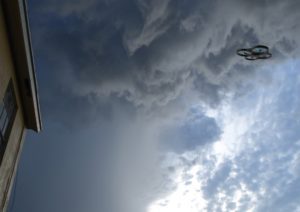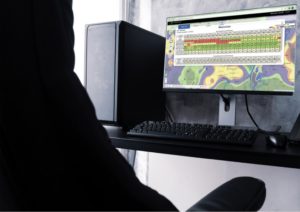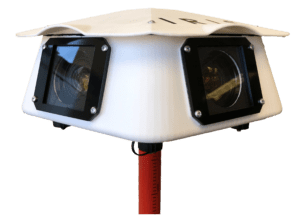
by DRONELIFE Staff Writer Ian M. Crosby
Weather data analytics provider TruWeather Solutions today announced a partnership with safety avionics leader Iris Automation for the integration of TruWeather’s micro weather services and weather sensors into Iris Automation’s Casia G ground-based surveillance system (GBSS). This collaboration will provide operators with access to real-time integrated communications, collision avoidance and micro-weather data.
Micro weather or low-altitude local atmospheric conditions are often drastically different from those in higher altitudes, resulting in a degree of uncertainty for uncrewed aircraft systems (UAS) and advanced air mobility (AAM) operations. An FAA-funded study at MIT Lincoln Lab found that only 3% of the U.S. has access to reliable surface weather and cloud ceiling report measurements.

To address this issue, TruWeather has shifted its attention to sensor placement and density optimization in order to capture microscale features with rapid update. TruWeather’s sensors can easily be incorporated into Iris Automation’s sensor agnostic Casia G.

“Micro weather information is critical to commercial drone operations, avoiding aborted flights and unnecessary risks and overhead in order to meet the FAA 107 weather minimums. Combined with Casia G, the TruWeather solution provides up to the minute, highly localized climate information to ensure safe drone operations in one easy setup,” said Lori DeMatteis, VP of Sales, Marketing and Customer Success at Iris Automation. “This meets the FAA’s stringent requirements and offers the ability to bring together all the required data in one dashboard. This partnership will drive the expansion of BVLOS safety best practices, offering clients immediate value to ensure operational safety, and rapidly changing climate information for emergency preparedness activities, ensuring both public and personnel safety.”
Read more about TruWeather:
- TruWeather on Dawn of Drones This Week! CEO Don Berchoff on Micro Weather Data and Advanced Ops
- Smart Rooftop or Ground Vertiports: TruWeather and Drone Industry Systems Corp
- TruWeather Solutions and Vertiport in a Box; Drone Industry Systems on Dawn of Drones This Week!
Read more about Iris Automation:
- Iris Automation Scores 2nd BVLOS Waiver: This Time with Casia G, Ground-Based Detect and Avoid
- Iris Automation BVLOS Approval for City of Reno Fire Department
- Iris Automation on Dawn of Drones This Week! Lori DeMatteis on Industry Diversity
Miriam McNabb is the Editor-in-Chief of DRONELIFE and CEO of JobForDrones, a professional drone services marketplace, and a fascinated observer of the emerging drone industry and the regulatory environment for drones. Miriam has penned over 3,000 articles focused on the commercial drone space and is an international speaker and recognized figure in the industry. Miriam has a degree from the University of Chicago and over 20 years of experience in high tech sales and marketing for new technologies.
For drone industry consulting or writing, Email Miriam.
TWITTER:@spaldingbarker
Subscribe to DroneLife here.